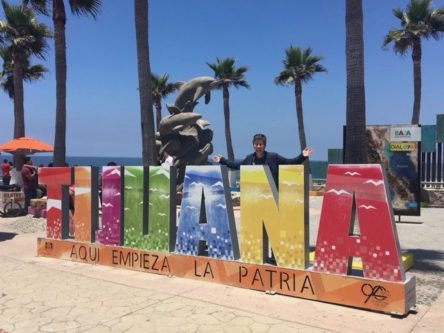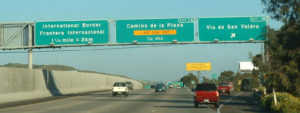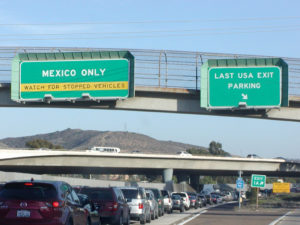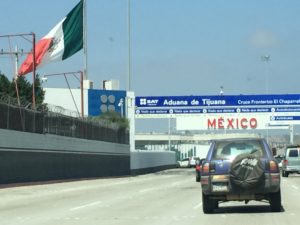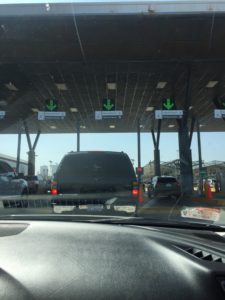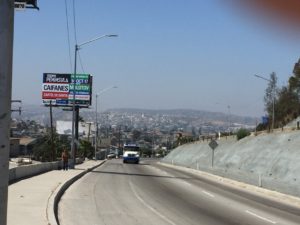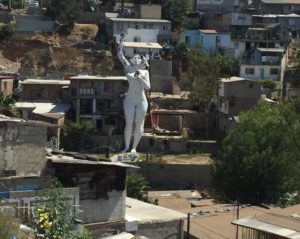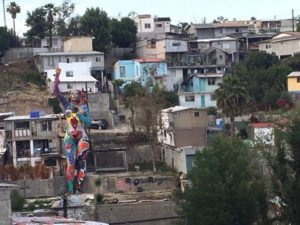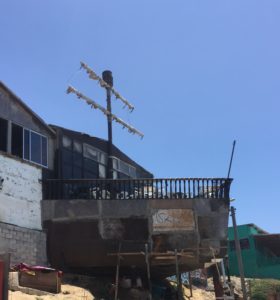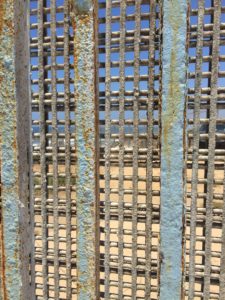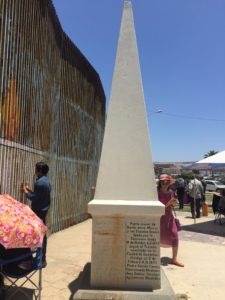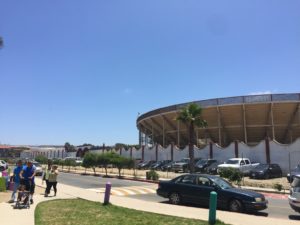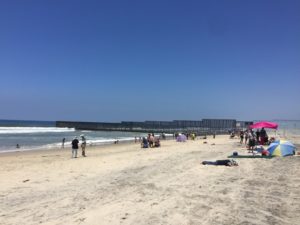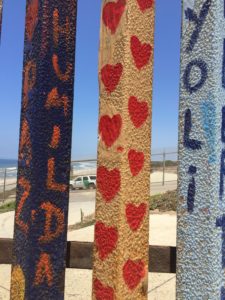[This post is the second in a series that chronicles my experiences on a day trip to Baja California Norte on 2 July 2017. Baja California or Bust: Part Zero explains the motivation behind this expedition.]
Fast forward to June 2017… As the 4th of July long weekend approached, it became abundantly clear that I needed a break from working way too much in the traffic-infested, dystopian wasteland of office parks, suburban tract homes, and strip malls that is Silicon Valley. Sitting at home in San Francisco early one Saturday morning, I caught a glimpse of my surfboard, lurking dejectedly in the background during a FaceTime call with my brother in London. The urge to go surfing prompted me to send a text to Carlos to inquire about the prospect of a return trip to San Diego. It did not take long before we resurrected our plan for a Tijuana adventure.
Shortly after 8 am on Saturday 1 July 2017, I strapped the surfboard to the roof of my geriatric, unwashed, yet still fully operational 2005 Volkswagen Passat station wagon and began piloting it southward towards San Diego. It was smooth sailing on I-5 until about 25 miles north of Los Angeles, at which point it became abundantly clear that many, many other people had similar ideas. I generally find long-distance car trips therapeutic, but it ended up taking 9.5 hours to drive 482 miles, which tested my patience considerably. Upon arrival, a few whiskey cocktails at an establishment in Normal Heights called Sycamore Den took the edge off. I did not, however, order this one, which is very, very wrong:
Since Mr. Volkswagen lacked the requisite Mexican auto insurance, Carlos and I set off, uncaffeinated and with empty stomachs, at 9:15 am on Sunday morning in his much more modern Mazda towards the San Ysidro border crossing, a mere 16 miles SSE of the Gaslamp Quarter in San Diego.
As we approached the border, the signage on I-5 began to more openly acknowledge our neighbors to south: translating “International Border” into Spanish, citing distances in kilometers, and alerting motorists that Exit 1A, Camino del la Plaza, is the “Last USA Exit.”
However, the word “Mexico” did not appear on a green freeway sign until less than a mile from the border, at which point another strategically positioned ginormous Mexican flag came into view. As it happens, ours is not the only country on Earth called the United States. The official name of Mexico is Estados Unidos Mexicanos, a factoid of which I was completely unaware until watching Ingobernable on Netflix a few months ago at Carlos’s behest.
As anticipated, our Sunday morning drive was blissfully free of traffic. We made it from La Jolla to the outskirts of Tijuana in approximately 20 minutes. Crossing into Mexico was only slightly more eventful than driving through the toll plaza on the Golden Gate Bridge. Motorists are forced to make a very sharp left turn past the blue “Nothing to Declare” lane markers above the roadway and then abruptly merge into two lanes, all the while periodically dodging randomly placed obstacles installed for the sake of security theater.
All of the drivers comported themselves with remarkable civility, waiting their turn, which would never have happened in Boston. Carlos commented that the US Government had compelled Mexico to install an expensive vehicle scanner that takes up an entire lane of traffic but essentially never gets used. Several bored-looking Mexican aduanas were half-heartedly inspecting the interiors of a few randomly selected vehicles.
As we entered the Zona Rio section of Tijuana, Carlos pointed out the inaugural segment of a massive rapid bus line upgrade that runs alongside the Tijuana River. It had all of the trappings of an ill-conceived boondoggle of a public infrastructure project for which Mexico is somewhat legendary. Our first stop was at a Banorte across from a megaplex movie theater to withdraw some pesos with which to purchase our breakfast, and snacks, and lunch, and beer, and cocktails, and dinner… I found it disconcerting that Mexican currency is also denoted by the $ sign. The peso took a nosedive after Trump got elected in November, but it has almost fully recovered. (Some currency traders probably made a killing.) The USD/MXN exchange rate was hovering around 17:1 that day. I withdrew 1500 pesos, or approximately 88 USD, from my Bank of America checking account entirely without incident. Carlos, the actual Mexican, ran into some issues. Two attempts at two different ATMs were met with epic failure. Then Bank of America started texting him about suspicious charges. He responded as instructed, attesting to his legitimacy. Within seconds, the red flag on his entry in the Magic Database of Account Holders in Good Standing in the Sky had been removed and the previously recalcitrant cajero automático disgorged his pesos.
Flush with Mexican currency, we drove more or less around the corner to the Sánchez Taboada branch of Los Chilaquiles, a local chain in a nondescript strip mall. The line snaked out the door.
While Carlos went inside to inquire about the wait time, this man looming over the parking lot, a plastic surgeon also named Carlos, caught my attention. That is quite a coup to secure the toll-free number 1-800-TIJUANA. I was in awe. (Dr. Carlos also advertised heavily next to the expressway directly adjacent to the San Ysidro border crossing.)
With only a few exceptions, most parking lots and streets in popular shopping or tourist areas that we stopped at were manned by late-middle aged men acting as parking attendants sporting high-vis vests. These guys seemed to self-organize and did not appear to have any official affiliation with the surrounding businesses. It is customary to exchange pleasantries with the attendant after you get out of your car to establish an understanding that he will keep an eye on your vehicle. When you’re ready to leave, you palm him 10-20 pesos if your car escaped unscathed, income that I’m guessing he does not report on his federal taxes.
The estimated wait time exceeded the limits our gurgling stomachs. We opted instead to decamp to another outpost of Los Chilaquiles near TJI airport and the Universidad Autónoma de Baja California. Carlos commented that it was fortunate that I didn’t go inside the first place, because the tasty food smells would have done me in. We were immediately seated and promptly ordered café de olla, coffee spiced with cinnamon and piloncillo (an unrefined Mexican sugar that dissolves quickly), a juice concoction called a Vampiro that had beets and carrots, tasted healthy, and turned my tongue purple, and Chilaquiles Benedicto, a riff on Eggs Benedict. Even though the establishment was not particularly busy when we showed up around 10:30 am, it took what seemed like an eternity for our food to come out.
The waiter pitied us after a while and comped some mollettes, open-faced sandwiches on bollilo, a local version of a baguette, slathered with beans, salsa, and cheese– the ultimate in Mexican comfort food. The mollette, for something so simple, packed a flavor punch and temporarily quashed my increasing hangriness. After more than 40 minutes, like a manna from heaven, our meal appeared. Admittedly, I am a foodie. However, I am definitely not a peddler of Instagram food porn, so I will use my words instead. Chilaquiles, if you have never experienced them, are a traditional Mexican breakfast dish that puts leftover tortillas and salsa to extremely good use. Judging from the waistlines of most of the patrons, los chilaquiles will quickly make you fat if you eat them in sufficient quantities. La cuenta served as a stark reminder that I reside in one of the most expensive cities in the universe. All of that food cost $19.54– for both of us.
Blood sugar levels back to normal, we did a quick drive-by of the airport, which has boomed since the introduction of the Cross Border Express in December 2015, an enclosed pedestrian overpass that enables easy access to TJI from the US side. Not many flights to Mexico depart from SAN, so Carlos often flies from and back to Tijuana to visit his family in Monterrey or travel to various destinations around Mexico, Central America, and South America for work.
We started to ascend one of the many hills within the city limits of Tijuana. Carlos randomly pulled over to the side of the road.
As we walked over to the edge of the sidewalk next to a small retaining wall, he said: “You’re probably wondering why I stopped here….” and then I saw Her. La Mona, a five story, hollow concrete statue that doubles as a residence and workshop for her creator, Armando Muñoz Garcia, nestled in the midst of a collection of ramshackle dwellings. Others have waxed poetic about La Mona to a greater extent than I ever could. Her exterior varies at the whims on the artist. She had recently been whitewashed when I clapped eyes on her, but Carlos had previously photographed her in a multi-colored bodysuit. Garcia has a grand vision to line the border with a procession of giant nude Amazons. It will likely not be actualized within his lifetime.
We made one final stop before venturing south along the Baja Peninsula at Les Playas de Tijuana to experience The Wall from the Mexican side.
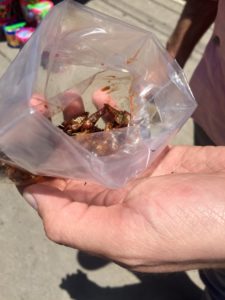 As we strolled northward along Avenida del Pacifico, Carlos stopped to purchase a plastic baggy full of chapulines, which happen to be in season, from a street vendor. They are, in fact, toasted grasshoppers from Oaxaca that are seasoned with garlic, lime juice and salt imbued with agave worm extract. I did make an exception and captured a photo for posterity, primarily to remind myself how of revolting they looked. Carlos gleefully consumed much of the bag, crunching away with abandon. It took considerable willpower on my part to eat a bug. I survived and it didn’t taste bad per se, but biting down on the fried chitinous exoskelton was not an experience that I wish to repeat. There are less disconcerting ways to incorporate protein into one’s diet. Mexican restaurants in American cities have started to hawk chapulines tacos to hipsters. Behold Exhibit A.
As we strolled northward along Avenida del Pacifico, Carlos stopped to purchase a plastic baggy full of chapulines, which happen to be in season, from a street vendor. They are, in fact, toasted grasshoppers from Oaxaca that are seasoned with garlic, lime juice and salt imbued with agave worm extract. I did make an exception and captured a photo for posterity, primarily to remind myself how of revolting they looked. Carlos gleefully consumed much of the bag, crunching away with abandon. It took considerable willpower on my part to eat a bug. I survived and it didn’t taste bad per se, but biting down on the fried chitinous exoskelton was not an experience that I wish to repeat. There are less disconcerting ways to incorporate protein into one’s diet. Mexican restaurants in American cities have started to hawk chapulines tacos to hipsters. Behold Exhibit A.
I couldn’t help but observe the stark contrast between this beach thoroughfare and, for instance, Manhattan Beach, CA, which has evolved into an overpriced, stylized, nouveau riche, yuppy hellhole. Les Playas de Tijuana– down-at-the-heels, decrepit, odorific, but full of character– is just beginning to show the first signs of gentrification. Real estate speculators will descend in droves before long. It will be fascinating to return in ten years.
And then there’s The Wall. Unlike the windswept wasteland on the American side, the Mexican section runs adjacent to a long stretch of sandy beach that was full of families enjoying a leisurely Sunday afternoon. Children were splashing in the surf, but stayed close enough to shore to avoid the obvious rip currents.
A section of the fence memorializes Mexican citizens who served in the U.S. Military. An adjacent section was painted blue by a Mexican-American artist from San Diego, Ana Teresa Fernandez, creating an optical illusion from certain vantage points that the wall has disappeared into the sea and the sky.
The pinky-through-mesh scenario through the fence surrounding Friendship Park is no joke.
This obelisk marks the first established border following the signing of the Treaty of Guadalupe Hidalgo that ended the Mexican-American War in 1848. The man in the blue shirt on the left of the photo is talking to one of his relatives through the wall. The Japanese tourist is preparing to take a selfie.
The Plaza Monumental de Tijuana (“The Bullring by the Sea”) was built in 1960 and seats approximately 20,000 people. As the popularity and social acceptability of bullfighting has waned, the venue hosts an increasing number of concerts, boxing matches, and other cultural events.
Our tax dollars at work, from a Mexican vantage point:
The last photo I took at Les Playas de Tijuana captures the persistent humanity on the Mexican side and the authoritarian sterility on the US side.
Coming up next in Baja California or Bust: Part Two– we head south on Carretera Federal 1D towards Ensenada and stop on the way to drink some Mexican craft beer.

